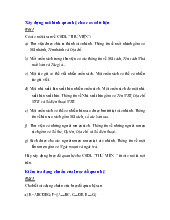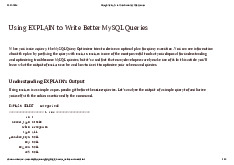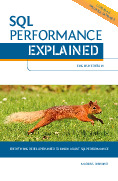



















Preview text:
Performance Tuning Best Practices Jay Pipes
Community Relations Manager, North America (jay@mysql.com)
TELECONFERENCE: please dial a number to hear the audio portion of this presentation.
Toll-free US/Canada: 866-469-3239
Direct US/Canada: 650-429-3300 : 0800-295-240 Austria 0800-71083 Belgium 80-884912 Denmark 0-800-1-12585 Finland 0800-90-5571 France 0800-101-6943 Germany 00800-12-6759 Greece 1-800-882019 Ireland 800-780-632 Italy 0-800-9214652 Israel 800-2498 Luxembourg 0800-022-6826 Netherlands 800-15888 Norway 900-97-1417 Spain 020-79-7251 Sweden 0800-561-201 Switzerland 0800-028-8023 UK 1800-093-897 Australia 800-90-3575 Hong Kong 00531-12-1688 Japan
EVENT NUMBER/ACCESS CODE: 921155876 Copyright MySQL AB The e W or o ld’s s Mo M s o t s P op o u p l u ar a O pe p n n S ou o rc r e D e at a a t ba b s a e s 1
MySQL: The World’s Most Popular Open Source Database
Founded in 1995; operations in 23 countries
Fastest growing relational database
Over 8,000,000 installations; 40,000 downloads / day
Dramatically reduces Total Cost of Ownership (TCO)
Used by leading IT organizations and ISVs Copyright 2005 MySQL AB
The World’s Most Popular Open Source Database 2 Second Generation Open Source •
MySQL AB is a profitable company
– Develops the software in-house; community helps test it
– Owns source code, copyrights and trademarks
– Targets the “commoditized” market for databases •
“Quid Pro Quo” dual licensing for OEM market
– Open source GPL license for open source projects
– Cost-effective commercial licenses for commercial use •
Annual MySQL Network subscription for Enterprise and Web
– Per server annual subscription
– Includes support, alert and update advisors, Knowledge Base, Certified/Optimized Binaries •
MySQL supports it users – Worldwide 24 x 7 support – Training and certification – Consulting
“Reasoning's inspection study shows that the
code quality of MySQL was six times better
than that of comparable proprietary code. ” Reasoning Inc. Copyright MySQL AB The e W or o ld’s s Mo M s o t s P op o u p l u ar a O pe p n n S ou o rc r e D e at a a t ba b s a e s 3 Overview ●
Profiling and Benchmarking Concepts ● Sources of Problems ● Indexing Guidelines ● Schema Guidelines ● Coding Guidelines ● Server Parameters Copyright MySQL AB The e W or o ld’s s Mo M s o t s P op o u p l u ar a O pe p n n S ou o rc r e D e at a a t ba b s a e s 4 Benchmarking Concepts ●
Provides a track record of changes ➢ Baseline is the starting point ➢ Testing done iteratively ➢
Deltas between tests show difference that the change(s) made ●
Stress/Load testing of application and/or database ●
Harness or framework useful to automate many benchmark tasks Copyright MySQL AB The e W or o ld’s s Mo M s o t s P op o u p l u ar a O pe p n n S ou o rc r e D e at a a t ba b s a e s 5 Benchmarking Tips ● Always give yourself a target ● Record everything ✔ Schema dump ✔ my.cnf files ✔
hardware/os configuration files as needed ● Isolate the problem ✔ Shut down unnecessary programs ✔
Stop network traffic to machine ✔ Disable the query cache ✔ Change one thing at a time Copyright MySQL AB The e W or o ld’s s Mo M s o t s P op o u p l u ar a O pe p n n S ou o rc r e D e at a a t ba b s a e s 6 Benchmarking Toolbox ● SysBench ➢
http://sysbench.sourceforge.net/ ● mysqlslap (5.1+) ➢
http://dev.mysql.com/doc/refman/5.1/en/mysqlslap.html ● Apache Bench (ab) ● supersmack ➢
http://www.vegan.net/tony/supersmack/ ● MyBench ●
http://jeremy.zawodny.com/mysql/mybench/ Copyright MySQL AB The e W or o ld’s s Mo M s o t s P op o u p l u ar a O pe p n n S ou o rc r e D e at a a t ba b s a e s 7 Profiling Concepts ● Diagnose a running system ● Low hanging fruit ➢ Diminishing returns ➢
Be careful not to over-optimize ●
Identify performance bottlenecks in ➢ Memory ➢ CPU ➢ I/O (Disk) ➢ Network and OS Copyright MySQL AB The e W or o ld’s s Mo M s o t s P op o u p l u ar a O pe p n n S ou o rc r e D e at a a t ba b s a e s 8 Profiling Toolbox ● SHOW Commands
➢ SHOW PROCESSLIST | STATUS | INNODB STATUS ➢ http://dev.mysql.com/show ● EXPLAIN ➢ http://dev.mysql.com/explain ● MyTop ➢
http://jeremy.zawodny.com/mysql/mytop/ ●
Whole host of Linux power tools ➢ gprof / oprofile ➢
vmstat / ps / top / mpstat / procinfo ● apd for PHP developers ➢
http://pecl.php.net/package/apd Copyright MySQL AB The e W or o ld’s s Mo M s o t s P op o u p l u ar a O pe p n n S ou o rc r e D e at a a t ba b s a e s 9 Slow Query Log ● Slow Query Log ●
log_slow_queries=/var/lib/mysql/slowqueries.log ● long_query_time=2 ● Use mysqldumpslow ●
(5.1+) Can log directly to a table, plus does not require restart of server ●
SET GLOBAL SLOW_QUERY_LOG = { ON | OFF }
● http://dev.mysql.com/doc/refman/5.1/en/log- tables.html Copyright MySQL AB The e W or o ld’s s Mo M s o t s P op o u p l u ar a O pe p n n S ou o rc r e D e at a a t ba b s a e s 10 1 Profiling Tips ●
Get very familiar with EXPLAIN ➢ Access types ➢
Learn the type, key, ref, rows, Extra columns ●
Low hanging fruit (diminishing returns) ●
Use MyTop to catch locking and long-running queries in real-time Copyright MySQL AB The e W or o ld’s s Mo M s o t s P op o u p l u ar a O pe p n n S ou o rc r e D e at a a t ba b s a e s 11 1 Sources of Problems ● Poor or nonexistent indexing ●
Inefficient or bloated schema design ● Bad SQL Coding Practices ●
Server variables not tuned properly ●
Hardware and/or network bottlenecks Copyright MySQL AB The e W or o ld’s s Mo M s o t s P op o u p l u ar a O pe p n n S ou o rc r e D e at a a t ba b s a e s 12 1 Indexing Guidelines
● Poor or missing index fastest way to kill a system
● Ensure good selectivity on field
● Look for covering index opportunities
● On multi-column indexes, pay attention to the order of
the fields in the index (example ahead)
● As database grows, examine distribution of values within indexed field
● Remove redundant indexes for faster write performance Copyright MySQL AB The e W or o ld’s s Mo M s o t s P op o u p l u ar a O pe p n n S ou o rc r e D e at a a t ba b s a e s 13 1 Common Index Problem
// This top query uses the index CREATE TABLE Tags ( // on Products2Tags
tag_id INT NOT NULL AUTO_INCREMENT
, tag_text VARCHAR(50) NOT NULL SELECT p.name , PRIMARY KEY (tag_id) , COUNT(*) as tags ) ENGINE=MyISAM; FROM Products2Tags p2t CREATE TABLE Products (
INNER JOIN Products p
product_id INT NOT NULL AUTO_INCREMENT
ON p2t.product_id = p.product_id
, name VARCHAR(100) NOT NULL GROUP BY p.name; // many more fields...
, PRIMARY KEY (product_id)
// This one does not because
) ENGINE=MyISAM;
// index order prohibits it
CREATE TABLE Products2Tags ( SELECT t.tag_text
product_id INT NOT NULL , COUNT(*) as products , tag_id INT NOT NULL FROM Products2Tags p2t
, PRIMARY KEY (product_id, tag_id)
INNER JOIN Tags t ) ENGINE=MyISAM;
ON p2t.tag_id = t.tag_id
GROUP BY t.tag_text; Copyright MySQL AB The e W or o ld’s s Mo M s o t s P op o u p l u ar a O pe p n n S ou o rc r e D e at a a t ba b s a e s 14 1 Common Index Problem Solved CREATE TABLE Tags (
tag_id INT NOT NULL AUTO_INCREMENT
, tag_text VARCHAR(50) NOT NULL , PRIMARY KEY (tag_id) ) ENGINE=MyISAM;
CREATE INDEX ix_tag CREATE TABLE Products (
ON Products2Tags (tag_id);
product_id INT NOT NULL AUTO_INCREMENT
// or... create a covering index:
, name VARCHAR(100) NOT NULL // many more fields...
, PRIMARY KEY (product_id)
CREATE INDEX ix_tag_prod
) ENGINE=MyISAM;
ON Products2Tags (tag_id, product_id);
CREATE TABLE Products2Tags (
// But, only if not InnoDB... why?
product_id INT NOT NULL , tag_id INT NOT NULL
, PRIMARY KEY (product_id, tag_id) ) ENGINE=MyISAM; Copyright MySQL AB The e W or o ld’s s Mo M s o t s P op o u p l u ar a O pe p n n S ou o rc r e D e at a a t ba b s a e s 15 1 Schema Guidelines
● Inefficient schema another great way to kil performance
● Use the smal est data types necessary
➢ Do you real y need that BIGINT?
● Normalize first, denormalize only in extreme cases Copyright MySQL AB The e W or o ld’s s Mo M s o t s P op o u p l u ar a O pe p n n S ou o rc r e D e at a a t ba b s a e s 16 1 Schema Tips
● Consider horizontal y splitting many-columned tables (example ahead)
● Consider vertical y partitioning many-rowed tables ➢ Merge tables (MyISAM only) ➢ Homegrown ➢ Partitioning (5.1+)
● Fewer fields = Narrow rows = More records per block
● Use “counter” tables to mitigate query cache issues (example ahead) ➢ Essential for InnoDB Copyright MySQL AB The e W or o ld’s s Mo M s o t s P op o u p l u ar a O pe p n n S ou o rc r e D e at a a t ba b s a e s 17 1
Horizontal Partitioning Example CREATE TABLE Users (
user_id INT NOT NULL AUTO_INCREMENT CREATE TABLE Users (
, email VARCHAR(80) NOT NULL
user_id INT NOT NULL AUTO_INCREMENT
, display_name VARCHAR(50) NOT NULL
, email VARCHAR(80) NOT NULL
, password CHAR(41) NOT NULL
, display_name VARCHAR(50) NOT NULL , PRIMARY KEY (user_id)
, password CHAR(41) NOT NULL , UNIQUE INDEX (email)
, first_name VARCHAR(25) NOT NULL ) ENGINE=InnoDB;
, last_name VARCHAR(25) NOT NULL
, address VARCHAR(80) NOT NULL
CREATE TABLE UserExtra (
, city VARCHAR(30) NOT NULL user_id INT NOT NULL
, province CHAR(2) NOT NULL
, first_name VARCHAR(25) NOT NULL
, postcode CHAR(7) NOT NULL
, last_name VARCHAR(25) NOT NULL
, interests TEXT NULL
, address VARCHAR(80) NOT NULL , bio TEXT NULL
, city VARCHAR(30) NOT NULL
, signature TEXT NULL
, province CHAR(2) NOT NULL
, skills TEXT NULL
, postcode CHAR(7) NOT NULL
, company TEXT NULL
, interests TEXT NULL , PRIMARY KEY (user_id) , bio TEXT NULL , UNIQUE INDEX (email)
, signature TEXT NULL ) ENGINE=InnoDB;
, skills TEXT NULL
, company TEXT NULL , PRIMARY KEY (user_id) ) ENGINE=InnoDB; Copyright MySQL AB The e W or o ld’s s Mo M s o t s P op o u p l u ar a O pe p n n S ou o rc r e D e at a a t ba b s a e s 18 1
Horizontal Partitioning Benefits
● Main table has narrow rows, so...
✔ More records fit into a single data page
✔ Fewer reads from memory/disk to get same number of records
● Less frequently queried data doesn't take up memory
● More possibilities for indexing and different storage engines
➢ Al ows targeted multiple MyISAM key caches for hot and cold data Copyright MySQL AB The e W or o ld’s s Mo M s o t s P op o u p l u ar a O pe p n n S ou o rc r e D e at a a t ba b s a e s 19 1 Counter Table Example CREATE TABLE Products (
product_id INT NOT NULL AUTO_INCREMENT CREATE TABLE
, name VARCHAR(80) NOT NULL Products (
, unit_cost DECIMAL(7,2) NOT NULL
product_id INT NOT NULL AUTO_INCREMENT , description TEXT NULL
, name VARCHAR(80) NOT NULL
, image_path TEXT NULL
, unit_cost DECIMAL(7,2) NOT NULL
, PRIMARY KEY (product_id) , description TEXT NULL , , INDEX (name(20)) image_path TEXT NULL ,
) ENGINE=InnoDB; // Or MyISAM
num_views INT UNSIGNED NOT NULL
, num_in_stock INT UNSIGNED NOT NULL
CREATE TABLE ProductCounts (
, num_on_order INT UNSIGNED NOT NULL
product_id INT NOT NULL
, PRIMARY KEY (product_id)
, num_views INT UNSIGNED NOT NULL , INDEX (name(20))
, num_in_stock INT UNSIGNED NOT NULL
) ENGINE=InnoDB; // Or MyISAM
, num_on_order INT UNSIGNED NOT NULL
// Getting a simple COUNT of products
, PRIMARY KEY (product_id)
// easy on MyISAM, terrible on InnoDB ) ENGINE=InnoDB; SELECT COUNT(*) FROM Products;
CREATE TABLE ProductCountSummary (
total_products INT UNSIGNED NOT NULL ) ENGINE=MEMORY; Copyright MySQL AB The e W or o ld’s s Mo M s o t s P op o u p l u ar a O pe p n n S ou o rc r e D e at a a t ba b s a e s 20 2




